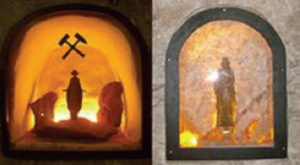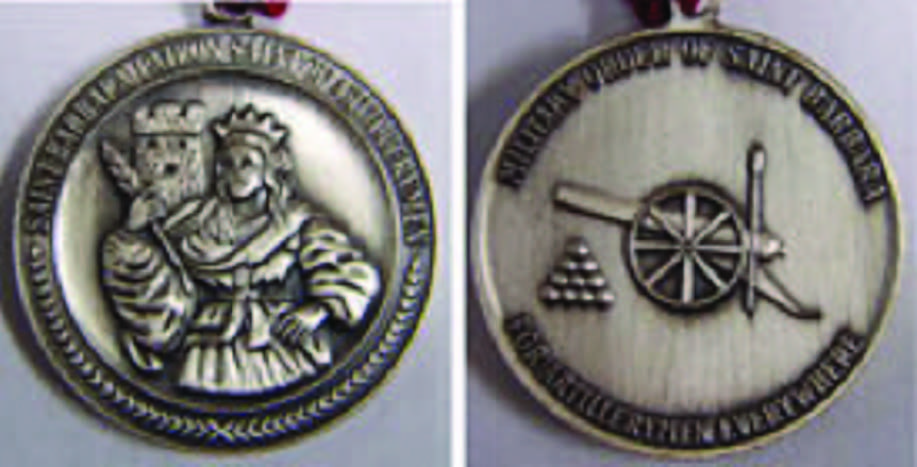by Brad Bockey
Saint Barbara is the patron saint of miners. She is among the 14 Holy Helpers of the Roman Catholic Church, the "Patron of Good Death."
Saint Barbara is probably the longing of the miners for light, transferred from the Christian legend. Since the Day of Saint Barbara is also celebrated in non-Catholic regions, its origin likely dates back to before the Reformation. Even in Protestant areas St. Barbara has kept her position despite the disapproval of the veneration of the saints.
ST. BARBARA DAY
The “St. Barbara Day” is on December 4th. In many families of our country the custom of the “Barbara branch” has been upheld. On this day cherry tree sprigs are cut and placed in a vase filled with water close to the light. After 21 days, exactly at Christmas, these branches blossom. Before the “Christmas tree” was known more than 100 years ago in the Westerwald, the Barbara sprigs were regarded as a symbol of Christmas as well as Christmas decoration. With their blossoms they symbolize the light and remind people that the spring sun, which will produce new flowers, is not far off. Barbara altars and windows can be found in almost all the churches of the mining communities.
THE CHRISTIAN LEGEND
According to the Christian legend Barbara lived at the end of the 3rd century AD in Nicomedia, which is now known as Izmit in Turkey, and was the daughter of a rich, pagan businessman named Dioscuros. Against her father’s will the pretty, young woman chose Christianity and was baptized. Out of sheer anger over her dedication to the new religion, hated and revered by him, Dioscuros held Barbara captive in a tower in order to dissuade her from Christianity. Neither the imprisonment nor the punishments inflicted on her by her father would persuade her against her choice; on the contrary, they strengthened her faith in Christianity.
Barbara managed to flee and hid in a rocky cliff, that opened and allowed her to hide. This is how she became the patron saint of miners. However, her refuge was betrayed, and out of sheer hatred Dioscuros condemned her and the governor of that time sentenced her to death. Her own father beheaded her, but was then hit by a deadly bold of lightning.
Barbara celebrations as well as devotions on December 4th have become long-standing customs, particularly in mining regions. On this day the miners commemorate their patron saint, St. Barbara. Therefore, each year on Dec. 4th there is a quiet, solemn atmosphere in front of the “Erbstollen”of Copper Plate (drainage tunnels of copper plate), and one is grateful for the accident-free mining year and prays once again for protection.
PATRONAGE

mines Schacht Konrad (left) and
Schacht Asse II (right).
Saint Barbara became the patron saint of artillerymen. She is also traditionally the patron of armourers, military engineers, gunsmiths, miners and anyone else who worked with cannon and explosives. She is invoked against thunder and lightning and all accidents arising from explosions of gunpowder. She is venerated by Catholics who face the danger of sudden and violent death in work.
The Spanish word santabárbara, the corresponding Italian word Santa Barbara, and the obsolete French Sainte-Barbe signify the powder magazine of a ship or fortress. It was customary to have a statue of Saint Barbara at the magazine to protect the ship or fortress from suddenly exploding. She is the patron of the Italian Navy. Saint Barbara’s Day, December 4, is celebrated by the British (Royal Artillery, RAF Armourers, Royal Engineers), Australian (Royal Regiment of Australian Artillery, RAAF Armourers), Canadian (Explosive Ordnance Disposal Technicians (EOD), Canadian Air Force Armourers, Royal Canadian Artillery, Canadian Military Field Engineers, Royal Canadian Navy Weapons Engineering Technicians), New Zealand (RNZAF Armourers, RNZA, RNZN Gunners Branch) armed forces. Additionally, it is celebrated by Irish Defence Forces Artillery Regiments, Norwegian Armed Forces Artillery Battalion, United States Army and Marine Corps Field and Air Defense Artillery, many Marine Corps Explosive Ordnance Disposal Technicians, and other artillery formations. The units and sub-units celebrate the day with church parades, sports days, guest nights, cocktail parties, dinners and other activities. Several mining institutions also celebrate it, such as some branches of the Australian Institute of Mining and Metallurgy. The West Australian Mining Club celebrate St Barbara's Day and use it to remember those people who have died working in the mining industry during the year. Although they do not celebrate her saint's day, she is also the patron saint of US Navy and Marine Corps Aviation Ordnancemen.
Santa Barbara Night is celebrated by the Norwich University Independent Battery.
In Greece, the day is celebrated by the Artillery Corps of the Greek Army and the Cypriot National Guard. Artillery camps throughout the two countries host celebrations in honor of the saint, where the traditional sweet of loukoumades is offered to soldiers and visitors, allegedly because it resembles cannonballs. Saint Barbara is also the patron saint of the northern Greek city of Drama, where a sweet called varvara, which resembles a more liquid form of koliva, is prepared and consumed on her feast day.
The Spanish military artillerymen, mining engineers and miners also venerate her as patron saint. Parades, masses, dinners and other activities are held in her honour.
The city of Santa Barbara, California, located approximately 100 miles northwest of Los Angeles, is named for the Mission Santa Barbara. The Franciscan mission was dedicated to her in 1602 after Sebastián Vizcaíno survived a violent storm just offshore on the eve of her feast day. Other Spanish and Portuguese settlements named Santa Barbara were established in Brazil, Chile, Colombia, Honduras, Mexico, Venezuela, and the Philippines. Many churches in Russia are dedicated in her name, including one in Moscow, next to Saint Basil's Cathedral, and in Yaroslavl. In the Afro-Cuban religion of Santería she is syncretized with Chango, the deity of fire, lightning, and thunder. In Afro-Brazilian religions of Candomblé and Umbanda, she is often identified as Yansan, the orisha of wind and storms.
In Georgia, Saint Barbara's Day is celebrated as Barbaroba on December 17 (which is December 4 in the old style calendar). The traditional festive food is lobiani, bread baked with a bean stuffing. In Macedonia Saint Barbara's day is celebrated as Варвара (Varvara) on 17 December. Some Macedonians celebrate with their closest family and friends at home, while others refrain, believing that people who step in their house on Saint Barbara's day will give them either good or bad luck for the rest of the year. In the mining town Kalgoorlie, Australia, as patron saint of miners she is venerated in the annual St. Barbara's Day parade.
In the Irish Army she is venerated as the patron saint of the Artillery Corps and appears on the corps insignia, half dressed, holding a harp, sitting on a field cannon. In the Czech Republic, a statue of Saint Barbara is placed near the future tunnel portal portal during the groundbreaking ceremony of most major tunneling projects, owing to her being the patron saint of miners. In Lebanon, Saint Barbara's day is celebrated by most Christians in the region. The celebration resembles a little bit to the American Halloween. Kids will dress up or wear costumes and wander the streets from house to house singing songs about the road Saint Barbara took to flee from her father. In Armenia, a cave shrine to Saint Barbara (Kuys Varvara) is locate on the slopes of Mount Ara and tribute of lit candles and flower garlands are used as tribute.
THE ORDER OF SAINT BARBARA

The United States Army Field Artillery Association and the United States Army Air Defense Artillery Association maintain the Order of Saint Barbara as an honorary military society of the United States Army Field Artillery and the United States Army Air Defense Artillery. Members of both the United States Army and United States Marine Corps, along with their military and civilian supporters, are eligible for membership.
There are two levels of membership in the order. The Honorable Order of St. Barbara, a silver medallion with red ribbon, is granted for long-term distinguished service in the Field Artillery or Air Defense Artillery corps. Appointment to the Honorable Order may be approved by the first colonel or the seniormost lieutenant-colonel in the chain of command. The most distinguished level is The Ancient Order of Saint Barbara, a gold-colored medallion with red ribbon. Those who are selected for this honor have achieved long-term, exceptional service to the field artillery surpassing even their brethren in the Honorable Order of Saint Barbara. The Ancient order must be approved of by the Commanding General, United States Army Fires Center of Excellence at Fort Sill. Also she is the patron saint of the Royal Artillery, British Army and is celebrated every December.
IN MODERN POPULAR CULTURE
Saint Barbara's day or Eid il-Burbara is celebrated in Lebanon, Syria, Jordan and Palestine, Israel among Arab Christians annually on December 4, in a feast day similar to that of North American Halloween. The traditional food for the occasion is Burbara, a bowl of boiled barley, pomegranate seeds, raisins, anise and sugar. Walnuts or almonds can be added. The general belief among Lebanese Christians is that Saint Barbara disguised herself in numerous characters to elude the Romans who were persecuting her.
